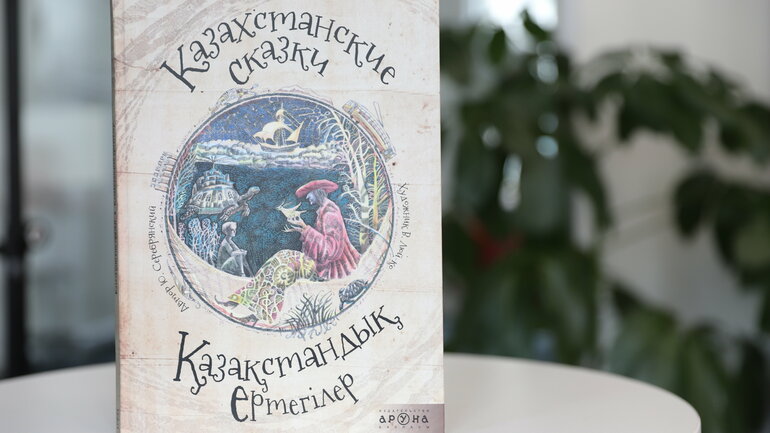Fairytales with a critical twist

Kazakhstan is the most ethnically diverse state in the post-Soviet space. The most recent official census, conducted in 2009, identifies 125 nationalities living in this Central Asian country. Granted, after Kazakhstan gained its independence in 1991, there was a resurgence of national identity, with renewed importance attached to anything and everything that qualified as “Kazakh”. Unlike the situation in other post-Soviet states, however, the political elite has consistently emphasised that the country is the homeland of all the Kazakhstani people, irrespective of ethnicity. Nevertheless, the concept of an inclusive identity for all citizens, captured in the term “Kazakhstani”, has yet to gain traction.
A work of literature published in 2017 makes an attempt to address this challenge by creating a blueprint for identity for all Kazakhstanis, whatever their ethnic background. Kazakhstani Fairytales was written by Yuriy Serebryansky, himself from a multiethnic family of Polish descent. This collection of fairytales, marketed as children’s literature, contains not only the author’s Russian texts but also their Kazakh translations – a novelty in Kazakhstan’s literary scene, and one which underscores the work’s aspiration to promote integration: as a bilingual text, it is accessible to almost every Kazakhstani.
Real-world issues, elements of fantasy
At the heart of Yuriy Serebryansky’s Kazakhstani Fairytales are real-world issues (such as the shrinking of the Aral Sea), cultural artefacts (the national flag) and real places (often Almaty) that will be familiar to Kazakhstani readers from their everyday lives. But the author places them in a fictional world, interspersing and enriching them with fantastical elements: gods, magic or anthropomorphised animals. In one of the fairytales, for example, the Aral Sea vanishes after it sets out to look for its father, the ocean, and its brothers, the seas. This is not to deny human responsibility for one of the greatest environmental disasters in the region; rather, it is about raising awareness of this very topic. The main point of the text, though, is to encourage the book’s target readership – children – to think and ask questions, rather than serving as a rallying cry.
Another of the tales describes how a king builds a city on a mountain slope and sends messages in bottles to his subjects through a system of channels. The king wonders why his people never reply, but assumes this is due to their general sense of contentment. It does not occur to him that a message in a bottle cannot float uphill. It is not much of a leap to see this as an implied criticism of the ruling elites in Kazakhstan itself, where communication between leaders and citizens is also one-way. The note of criticism sounded in the fairytale is attenuated by the thoroughly benevolent portrayal of the king as a kindly ruler – one who genuinely has his subjects’ best interests at heart yet is so unworldly that he loses sight of the simple laws of nature.
It is these elements – which rely on a process of recognition and decoding – that link the texts and lend them their particular charm: anyone who is able to decipher the cultural code of the fairytales is part of this community. For that, an awareness of conditions in Kazakhstan suffices. And this is where Serebryansky’s blueprint for identity, his offer to his readers regardless of age or origin, comes into play.
“Permitted” social criticism
The social criticism – muted, but nonetheless discernible to anyone familiar with everyday life in Kazakhstan – in Kazakhstani Fairytales is remarkable, given the massive government-imposed restrictions on freedom of expression and press freedom. Journalists and bloggers in Kazakhstan have to contend with censorship and repression, but Kazakhstani writers of literature feel less constrained, according to authors I spoke to in a series of interviews in Almaty and Astana (now Nur-Sultan) in May and June 2017. Serebryansky himself says in an interview in April 2019 that the critical elements contained in his book had elicited no reaction from the state and are therefore presumably within “permissible” limits. Indeed, one of the stories in Kazakhstani Fairytales was selected for inclusion in an anthology of contemporary Kazakhstani literature, which will be translated into the six UN languages and sold worldwide. Although – to quote the author – “a relatively uncomplicated story” was chosen, its inclusion in this major cultural project shows that the country’s cultural elite has taken note of Kazakhstani Fairytales and is willing to allow a measure of criticism, at least at this level.
So what explains the relative freedom enjoyed by literature in Kazakhstan? First and foremost, it is due to the declining importance assigned to literature by political elites across the post-Soviet space. During Soviet times, literature was one of the state’s most important propaganda tools and was therefore an object of close scrutiny. Today, however, this function is performed by TV and the Internet. This means that literature enjoys a degree of latitude not currently available to other media. On the downside, it no longer reaches the wide readership that it enjoyed in the Soviet era.
In the interview, Serebryansky emphasises that it was not his intention to write a book about politics. Granted, the book presents neither a political agenda nor a blueprint for a different Kazakhstan, less still a political call to action. Had it done so, it would never have made it into print, despite the leadership’s lukewarm attitude towards literature. Nevertheless, with its aspiration to create a body of folklore for all Kazakhstanis, whatever their ethnicity, and build a sense of identity, Kazakhstani Fairytales is an expression of commitment to an open tolerant and multicultural society at a time of burgeoning nationalism. In that sense, it most certainly does make a political statement.
Nina Frieß is a researcher at ZOiS, specialising in Slavic literatures and cultures. This issue of Spotlight is an abridged version of her forthcoming ZOiS Report “Kazakhstani Fairytales – A literary blueprint for inclusive Kazakhstani identity”.